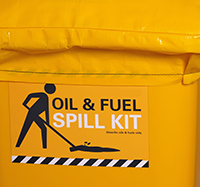P2 Section #5 | General P2 Opportunities - Pg 2

Section 5 | General P2 Opportunities
Revised On: March. 17, 2024 - 8:00 p.m.
Facility-Wide P2 Opportunities
After covering some of your facility's water and energy opportunities, we’ll continue with the facility-wide theme and look at ways to incorporate pollution prevention through daily activities.
Shop Cleanup

Proper cleaning methods can mitigate much of the pollution discussed in the previous training topics. Anytime harmful products are used at your facility, some may spill onto the floor or later deposit onto surfaces throughout your workplace. Surfaces should always be cleaned with minimizing the use of any liquid in mind. Dry cleanup methods, such as sweeping or dry rags, are preferable to minimize the potential for contaminated water runoff or generating additional hazardous wastes. If a liquid spill is contained, consider using a squeegee and dustpan to collect liquids instead of resorting to absorbents.
Spill and Leak Prevention & Preparedness

Spills and leaks are common occurrences that can cause significant losses over time. Although visual inspections can help to catch leaks, they are not always easy to detect. During visual inspection, watch for pooled liquid, drips, and signs of structural damage. This isn’t just for equipment or plumbing fixtures that need inspection; also, examine the products you’re using for damage to the containers or signs of leakage, like worn or discolored labels. This could also be done in off-hours to listen for possible leaks. Regular preventative maintenance should be a top priority to ensure all piping and fittings are in good condition and do not fail during operations. These activities will reduce the likelihood of releases or stop ongoing leaks.
To prepare for spills, ensure you know where the property's drains are. This will help you to quickly identify if spills/leaks are at risk of entering drains. Preparing a spill kit will also ensure you are ready for any incidents. Spill kits should contain at least PPE, absorbent materials, and a waste container. This kit should then be placed near any potential spill areas so it can be contained and cleaned before release to any drains or soil and limit exposure to staff. The final element is to plan for if a spill or leak occurs and ensure the spill kit is maintained. Do you know who is responsible for taking action against the spill and how to respond to the chemicals on-site? These are elements of a spill response plan that should be known and can be done through regular training.
For spills that occur and are cleaned, use the incident as a learning opportunity to prevent it from happening in the future. You may find that there are certain activities or equipment that are more prone to causing accidents. This can be done by documenting the cause of the incident, the chemicals involved, and the response taken. This will help you when you implement a solution that will prevent the incident from happening again.
Housekeeping
- Keeping the facility organized and clean contributes to waste reduction by preventing accidents or releases of pollutants. Here are a few critical components of good housekeeping:
- Keep walkways clear - Clear walkways mean there are dedicated paths for staff to move through with the expectation of no obstructions. Cluttered environments invite the possibility of staff tripping or slipping when trying to get to another part of the facility.
- Clean regularly - Don’t allow the buildup of waste or dust within your facility. Excessive dust buildup becomes a fire hazard and increases exposure to hazardous constituents.
- Inspect waste disposal areas for leaks - Regular checks of disposal areas can prevent long-term environmental damage. For this reason, disposal containers should not be placed near drains or uneven surfaces. If leaks are found, the container should be immediately repaired or replaced.
- Keep containers closed - This extends to any container at the facility that is not being used. If an open container is left outside, it can accumulate rainwater and contaminants that ultimately add difficulty in disposal. In addition, an inspector may ask that the liquid be tested if it can’t be identified and has potentially damaging characteristics like an oily sheen.
- Organize your workbench - Is everything at your workbench necessary for the work, and do you have what you need to perform the work? This should be asked before starting any work. Keeping your workbench organized and ready makes it easier to perform work and limits how much you need to leave to get parts/supplies, reducing accidents.
In the next lesson, we will talk about P2 Opportunities for Business Owner Considerations.
GUIDES
Implementing P2 > | Spanish >
Inventory Control > | Spanish >
Solvent-Contaminated Wipes >
Used Oil >
Waste Determination >
POSTERS
Clear Walkways > | Spanish >
Clean Workspace > | Spanish >
First-In, First-Out > | Spanish >
Use & Stow > | Spanish >
VIDEOS
Auto Shop Housekeeping>
FIFO for Auto Shops >
What is P2 >
OTHER
P2 in Action >
